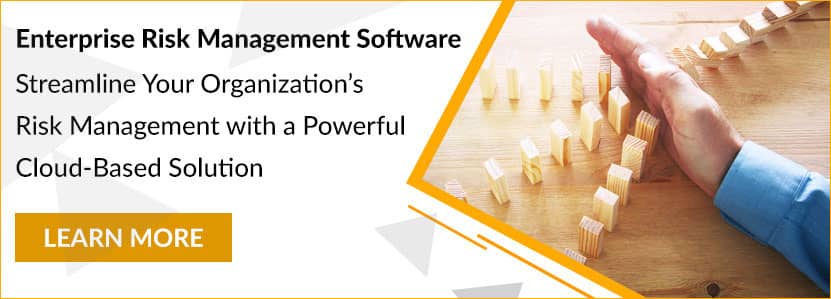Home/ Blog / 6 Steps for a Proactive Mid-Sized Bank Risk Management Framework
Recent developments in the regtech domain have made risk and compliance technology accessible and affordable for small and mid-sized banking and financial institutions. These developments have opened new possibilities for local banks. Large nationwide banks have always had access to the latest risk and compliance technology because they could afford to spend millions of dollars on technology implementations. The availability of easy-to-procure integrated risk management platform means that small and mid-sized banks can use the same sophisticated technology as their larger counterparts.

Bank Risk Management Framework
It is important for banks to not just focus on a part of risk management but to improve the core bank risk management framework. Structural improvements like a better risk management platform may seem like a daunting undertaking but the rewards of structural improvement easily outweigh any costs or efforts required to bring them about. Improving the framework provides the banks with better risk intelligence, mitigation, and prediction capabilities for many years to come. It enables bank management to make a better executive decision while also ensuring that the risk management department runs at peak efficiency.
Here are 6 steps that small and mid-sized banks can take right now to make their bank risk management framework more proactive:
1 – Automate Risk Identification
Anticipating market is a necessity for banks and identifying emerging risks is crucial to track market movements. Banks stabilize the market by providing credit to businesses and helping economies grow; banks can act as a stabilizing force because they focus on predicting market movements and make resources available accordingly.
There are many different types of solutions available that help banks identify risks. Simple tools can provide the latest risk news and intelligence, allowing risk managers to be better informed about emerging risks. Some solutions track market data and projections to predict problematic trends and opportunities. There are AI powered solutions which can detect emerging risks. Banks can choose the type of solution they need depending on their business requirements and available budget.
Large nationwide banks have always had access to the latest risk and compliance technology because they could afford to spend millions of dollars on technology implementations. The availability of easy-to-procure cloud-based risk solutions means… Share on X2 – Streamline Risk Analysis
Banks can streamline the risk analysis process either by automating the analysis or automating the analysis workflow. Risk management solutions can automatically analyze risks and create risk reports. The advantage of this is that the board always has access to real-time reporting. Banks can also opt to provide a risk analysis platform which helps risk managers work faster. Collaborative platforms cannot deliver the same speed as complete automation, but they still end up increasing risk analysis speeds significantly.
3 – Enable Real-Time Risk Prioritization
All businesses have limits on resources. That is why it is important to prioritize business activities and ensure that the most critical processes are being carried out. Small and mid-sized banks assess risks when they are identified but there is often no real-time risk assessment process in place. The level of a risk is only changed after a periodic reassessment or if the risk ends up affecting the business. Real-time prioritization ensures that if a risk increases in severity or probability the risk managers will be immediately notified and can act proactively.
4 – Codify Risk Accountability
Each department is responsible for the risks inherent in its work, banks often struggle to keep track of this accountability.. Businesses can encourage an increase in accountability by assigning stakeholders to different risk. Each employee should know which business risks they are responsible for so they can act accordingly. This shift in culture can result in an exponential improvement in risk management. Instead of the risk management team bearing all the burden, the whole organization is on the same page and is helping mitigate risks. We cannot expect people to be accountable in general – we need to tell them the specific risks they need to help manage.
5 – Risk Response Visibility
Visibility increases accountability and performance. Large enterprises use activity management platforms to track risk mitigation efforts across the organization. Their managers can see if any activity is delayed and intervene proactively. Small and mid-sized banks also need to ensure that all risk related activities across the organization are being monitored. Risk management platforms provide a central location for each employee to provide risk related data and information, which helps managers assess not just the risks that affect their organization but also assess their organization’s risk mitigation efforts.
6 – Continuous Risk Monitoring
Risks are not static – they are dynamic. New risks emerge while old risks may be eliminated. A risk may suddenly increase in severity or probability; it may similarly diminish in severity or probability. The only way to ensure that your business is making the right moves is to continuously monitor risks. This entails many different processes. Risk managers need to keep up with the latest news and risk intelligence. Risk metrics from across the world need to be monitored. There needs to be an automated tool that monitors your organization for cyber risks. Banks cannot monitor risks only during business hours; banks are affected by global market movements and thus need continuous monitoring.
These 6 steps will enable small and mid-sized banks to mitigate risks proactively without causing any financial strain on the banks. Want to see how your bank can improve the way it manages risks? Get in touch with our risk experts to see a demo of Predict360.
Request a Demo
Complete the form below and our business team will be in touch to schedule a product demo.
By clicking ‘SUBMIT’ you agree to our Privacy Policy.




